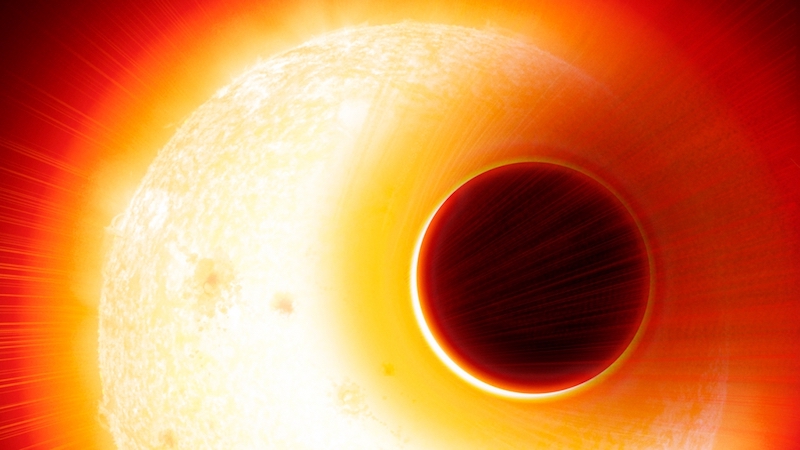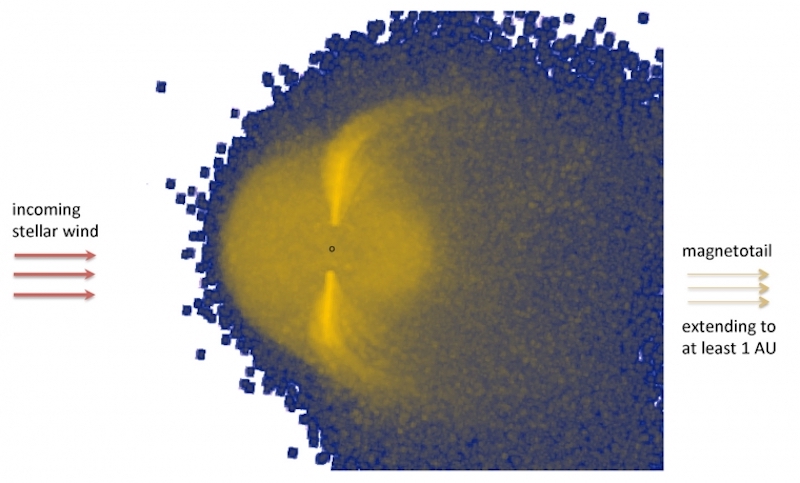
Most of the planets in our solar system, including Earth, have magnetic fields surrounding them. Now, for the first time, astronomers say they’ve discovered a magnetic field for an exoplanet, a world orbiting a distant star. The planet is about the size of Neptune and is 123 light-years from Earth. The international team of astronomers announced its finding in late December 2021. The scientists said they made the discovery using the Hubble Space Telescope.
The peer-reviewed journal Nature Astronomy published the findings on December 16, 2021.
EarthSky 2022 lunar calendars now available! Get yours now. Going fast!
The 1st known exoplanet magnetic field
The evidence for a magnetic field was found in Hubble observations of HAT-P-11b. Hubble saw the planet as it transited in front of its star, as seen from Earth. Overall, six transits were observed, in the ultraviolet light spectrum, a type of electromagnetic radiation. It is a part of the spectrum that the human eye cannot see.
Gilda Ballester at the University of Arizona Lunar and Planetary Laboratory and one of the paper’s co-authors stated:
This is the first time the signature of an exoplanet’s magnetic field has been directly detected on a planet outside our solar system. A strong magnetic field on a planet like Earth can protect its atmosphere and surface from direct bombardment of the energetic particles that make up the solar wind. These processes heavily affect the evolution of life on a planet like Earth because the magnetic field shelters organisms from these energetic particles.

Carbon ions point to a magnetosphere
So, how did Hubble actually detect the magnetic field? It did so by detecting carbon ions around the planet. These are charged particles that interact with magnetic fields. They form what is called a magnetosphere around the planet. The magnetosphere is created by a planet’s (or other object’s) interaction with the solar wind emitted by its host star. The presence of the magnetosphere shows that the planet must have a magnetic field. Ballester added:
HAT-P-11 b has proven to be a very exciting target, because Hubble’s UV transit observations have revealed a magnetosphere, seen as both an extended ion component around the planet and long tail of escaping ions.
The carbon ions were found not only around the planet, but also in a long “tail” – called a magnetotail – streaming away from the planet. The phenomenon is reminiscent of a comet’s tail. The average speed of the particles is an incredible 100,000 mph (160,900 kph). The tail itself is a also quite long, about one astronomical unit (AU), or the distance between the Earth and the sun. Earth also has its own magnetotail.

3-D Computer simulations
In order to learn more about the exoplanet’s magnetic field, the researchers used 3-D computer simulations. The paper’s first author, Lofti Ben-Jaffel at the Institute of Astrophysics in Paris, used them to model interactions between the planet’s uppermost atmosphere and magnetic field with the incoming solar wind. Lofti Ben-Jaffel said:
Just like Earth’s magnetic field and its immediate space environment interact with the impinging solar wind, which consists of charged particles traveling at about 900,000 mph (1,450,000 kph), there are interactions between HAT-P-11b’s magnetic field and its immediate space environment with the solar wind from its host star, and those are very complex.
Similar to Earth yet different
In terms of physics, the magnetospheres of HAT-P-11b and Earth are pretty much the same. However, HAT-P-11b is not like Earth. Discovered in 2008, it is about the size of Neptune and orbits much closer to its star than Earth does to the sun. In fact, the planet lies twenty times closer to its star, completing an orbit in only 4.9 days. This means, naturally, that it is much hotter and its upper atmosphere basically boils off into space. This is what creates the long magnetotail.
Also, in some ways the planet resembles Jupiter more than it does Neptune. Its atmosphere has a low metallicity, like the atmospheres of Jupiter and Saturn. Neptune and Uranus, on the other hand, have high metallicity atmospheres but weak magnetic fields. This makes HAT-P-11b more like a mini-Jupiter than a Neptune. Metallicity is the abundance of elements present in an object that are heavier than hydrogen and helium.

As Ballester explained:
Although HAT-P-11b’s mass is only 8% of that of Jupiter, we think the exoplanet more resembles a mini-Jupiter than a Neptune. The atmospheric composition we see on HAT-P-11b suggests that further work needs to be done to refine current theories of how certain exoplanets form in general.
Clues about planetary habitability
While HAT-P-11b is very un-Earthlike, and likely uninhabitable, its magnetosphere and magnetic field can still provide important clues about the habitability of exoplanets. This is especially true since it is Earth’s magnetic field that protects life from the deadly solar radiation coming from the sun.
Bottom line: An international team of astronomers has discovered a magnetic field on exoplanet HAT-P-11b, a Neptune-sized world 123 light-years away. It is the first discovery of a magnetic field on a planet outside our solar system.
Source: Signatures of strong magnetization and a metal-poor atmosphere for a Neptune-sized exoplanet











